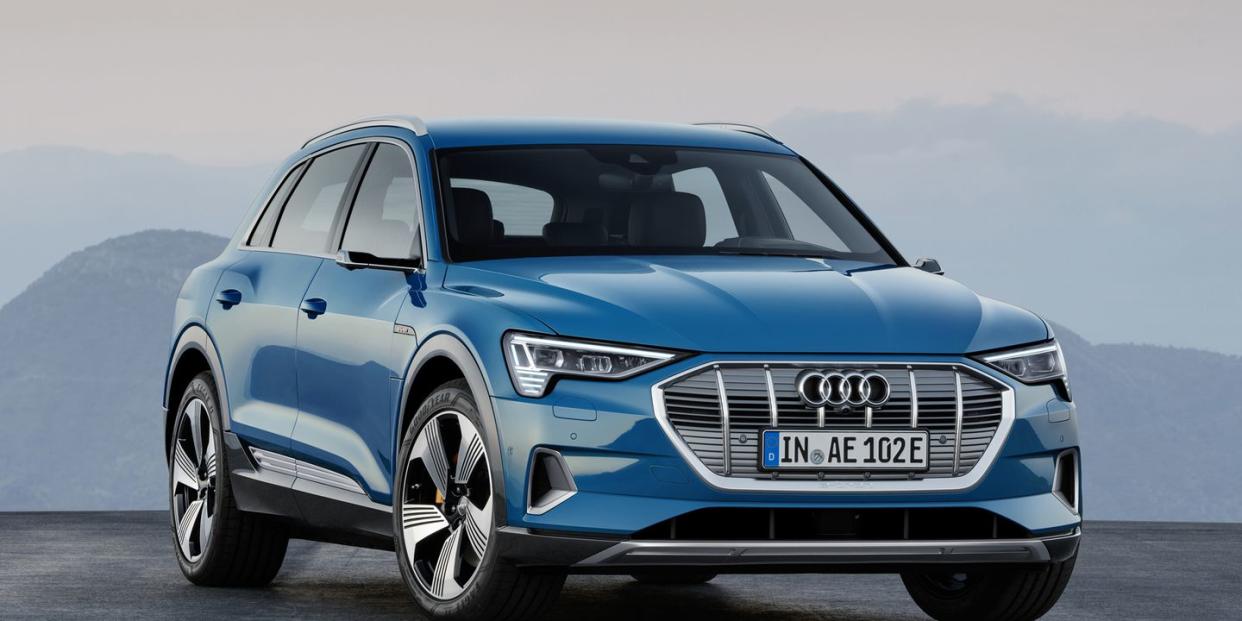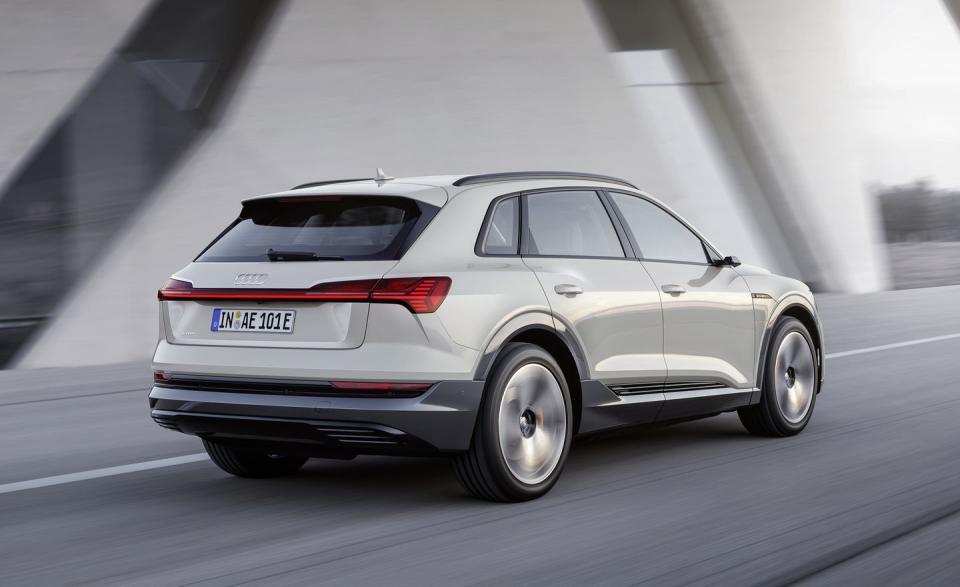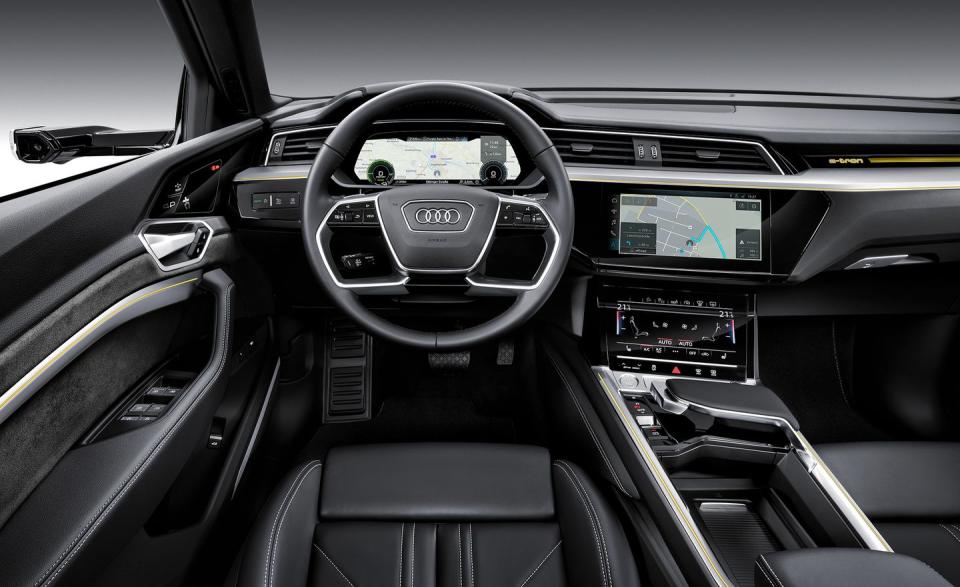The 2019 Audi e-tron Has Tomorrowland Technology In a Dapper Wrapper

For the last six years, we've seen what a recently formed electric car company led by an eccentric billionaire can do in the electric-vehicle space, but only recently have the established luxury automakers collectively determined that building dedicated electric cars is a worthwhile endeavor. First was Jaguar's impressive I-Pace, which went on sale in the United States earlier this year. And come the second quarter of next year, the 2019 Audi e-tron SUV will join the e-party, too. Until now, we've only seen it wearing camo, but with the wraps officially off, we've got lots of information about the first of many electrified products Audi plans to introduce in the next six years.
Some important stuff right away: The e-tron is a mid-size five-seat crossover that utilizes a heavily modified version of Audi's MQB modular platform. The vehicle stretches 193 inches in length, 76.3 inches wide, and 65.5 inches tall, making it a little bit smaller in each dimension than Audi’s new Q8 flagship SUV and five inches shorter and narrower than the Tesla Model X.
The e-tron's long, 115.1-inch wheelbase makes room for a two-tier battery pack that itself measures seven and a half feet long, more than five feet wide, and over a foot deep. The 95-kWh battery pack uses 36 individual shoe-box-size cells protected by a lattice structure, an aluminum tray beneath the vehicle, and ancillary safety systems. Audi did not release the official curb weight of the e-tron, but the battery system alone weighs 1543 pounds. Audi claims that, whatever it weighs, the mass is distributed approximately 50/50 front and rear, and that the center of gravity is several centimeters below that of conventional SUVs.

We do know that the e-tron is powered by two asynchronous motors-a 181-hp motor for the front axle and a 221-hp unit for the rear. Most driving is done using just the rear motor, but the front axle can be engaged within milliseconds, according to Audi. The e-tron's Drive Select system features seven driving modes that Audi claims range from "comfortable, though efficient" to "distinctively sporty." The e-tron's electric Quattro all-wheel-drive system can actuate torque predictively to each axle, based on weather and road surface or whenever the driver requests more power than the rear motor can supply. As an electric car, maximum torque can be reached pretty much instantaneously-in less than 250 milliseconds, Audi says-although unlike the Tesla Model X, the e-tron won't generate too many eye-popping performance headlines: its 5.5-second zero-to-60-mph time is brisk if not outright quick, and it tops out at a prudent 124 mph.
Certain driving modes affect how high the e-tron rides upon its suspension, which utilizes multilink setups front and rear plus standard air springs that can lift the vehicle 1.4 inches in its off-road setting and another 0.6 inches higher still in Raise mode. At higher speeds, the e-tron can automatically lower to decrease drag. Total height adjustment range between its lowest and highest settings is 3 inches.
The regenerative brakes on the e-tron use the electric motors as alternators for all braking tasks up to 0.3 g-over ninety percent of braking scenarios, according to Audi-after which point the friction brakes are also used. The driver can select among three different levels of energy regeneration, from zero regenerative braking and normal coasting to "one-pedal driving" with high regenerative braking, wherein the driver can slow the vehicle down merely by backing off the accelerator. Audi estimates that the recuperation of lost energy is responsible for a sizable chunk of the e-tron's range-up to thirty percent, depending on conditions, driving style, and terrain. Speaking of extending range, Audi's thermal-management efforts include a heat pump design that helps both prolong battery life and extend the e-tron's range by up to ten percent, depending on ambient temperature, according to Audi.
Audi did not provide the all-important range figure for the e-tron-at least not according to official U.S. EPA ratings-but it did say that in European tests, the e-tron's range is around 249 miles. Audi of America president Scott Keogh anecdotally told the story of how one of the 250 Audi e-tron prototypes that canvassed the globe during research and development drove from the e-tron's launch site at Craneway Pavilion on the Eastern shores of the San Francisco Bay 175 miles across California to South Lake Tahoe in the Sierra Mountains, arriving with 12 miles of range left. Then, after the vehicle was allowed to fully recharge "over a leisurely lunch," it was driven back to San Francisco and had an indicated 90 miles remaining upon its return.
Looks Like . . . an Audi SUV
If you happened to see any of those 250 prototypes whirring around, you might have dismissed it as a Q5 with a funky wrap job, rather than the tip of the spear with which Audi is charging into electromobility. No bat-wing doors, no glass dome windshield, just an Audi SUV that looks like an Audi SUV, albeit with perhaps the best proportions and stance of any Audi SUV to date. In a pre-launch discussion with Audi design chief Marc Lichte, he remarked that while designers had contemplated more radical designs, it was ultimately decided that the vehicle should have a familiar look. Part of the reasoning, we were told, was to ease the transition to electric-car living for newcomers: the switch itself is impactful enough without having to get used to something weird-looking in the driveway.

Besides the proportions, there are plenty of details that are unique to the e-tron, from its LED headlamps with four hashmark details to the LED taillamps that reach across the e-tron's tailgate à la the Q8 and A7, both of which are expected to become an e-tron signature as more EV derivatives emerge in future years. The single-frame grille, now more of a motif than an aperture, gives the e-tron a familiar Audi look, even though it's the first time it's been rendered in an inverted octagonal form. A chunky lower section rising toward the rear end serves to reduce the visual thickness of the e-tron's body while hinting at the existence of important stuff behind it, i.e. the battery and propulsion systems.
Unfortunately, U.S. regulators won't allow us to get e-tron's niftiest feature: exterior camera-based "mirrors" (which, interestingly, are shaped like the exterior mirrors they have replaced) that correspond to 7.0-inch OLED displays located near each front door pull at about the same level of Audi's Virtual Cockpit gauge cluster, which comes standard on the e-tron.
Those would be just two of many display-based systems inside the e-tron's techno-classy, flat-floored interior. Besides Virtual Cockpit, the e-tron features a 10.1-inch infotainment screen situated above a second, 8.6-inch screen used primarily for HVAC features and other settings. A head-up display is optional. And if that's not enough, one can bring their own screen in the form of a smartphone or tablet device and stream content via the standard 4G LTE Wi-Fi connection.
Other notable features include a tasteful four-spoke steering wheel, an L-shaped wrist rest with a discrete gear selection slider, and seat stitching that evokes circuit boards. The e-tron's Driver Assistance package uses the adaptive cruise-control system and its many attendant cameras and sensors to allow the e-tron to drive, brake, and steer for the driver, slowing for transition ramps, roundabouts and construction zones. The driver can also select a driving style for this mode of cruising, from "everyday to sporty" styles. It also features 360-degree camera system with a freely selectable 3D view, as well as park steering assist that handles steering functions while parallel or perpendicular parking.
While we're still at least six months from seeing the e-tron in U.S. dealerships, Audi has already set the base price at $75,795 for the Premium Plus trim level, which features 20-inch wheels with all-season tires, the overhead view camera system, blind-spot monitoring with cross-traffic alert, full LED lighting, navigation, a 705-watt Bang & Olufsen sound system with 16 speakers, leather upholstery, 12-way heated and cooled front seats, a panoramic sunroof, and more. For another $7000, the Prestige model brings a head-up display, more active-safety features, massaging seats, soft-close doors, rear-window sunshades, higher-end leather, and an air ionizer.
Americans will further have the chance to order one of the 999 First Edition models, which get Daytona Gray paint, 21-inch wheels, orange brake calipers and exterior trim, and black leather inside complemented by gray contrast stitching and gray ash wood trim.
All e-tron buyers will receive 1000 kWh of free energy from Audi and Electrify America, which promise to have 500 fast charging facilities either under construction or completed nationwide by July 2019, 160 of which will be in California. Interestingly, the e-tron is compatible with both AC and DC charging via the common SAE J1772 and Combined Charging System (CCS) standards. It's capable of DC fast charging at up to 150 kW when available at certain high-speed public charging stations; this capability can deliver up to an 80 percent charge in approximately 30 minutes. The e-tron will also welcome Amazon's Alexa virtual assistant into the car, who can be tasked with, among other things, managing at-home charging.
As of the e-tron's launch, a configurator is open on Audi's website, with orders and refundable $1,000 deposits being taken for mid-2019 deliveries, by which time even more luxury EVs will exist.
('You Might Also Like',)

